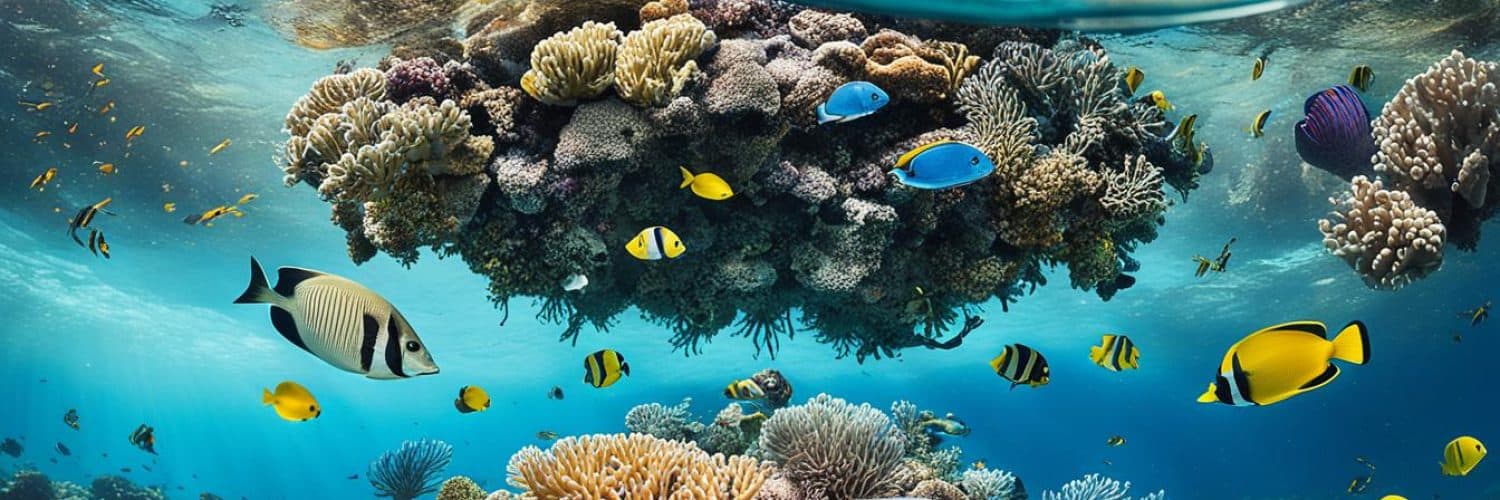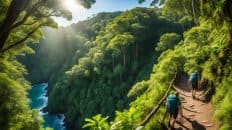When you hear the name Siquijor, what comes to mind? Perhaps stories of witchcraft, voodoo, and mystical events? It’s true that Siquijor, an island in the Philippines, has long been shrouded in legends and superstitions. But did you know that beneath its enigmatic surface lies a thriving hub for marine life conservation projects? Explore the surprising commitment of Siquijor to protect and preserve its precious marine biodiversity, and discover the wonders that lie beneath the waves.
Key Takeaways:
- Siquijor, known for its mystical reputation, is also dedicated to marine life conservation.
- The island is home to several Marine Protected Areas (MPAs), such as Caticugan Marine Protected Area and Tubod Marine Sanctuary.
- Coral reef rehabilitation programs, like RRREEFS, are at the forefront of preserving Siquijor’s marine ecosystem.
- Collaboration and partnerships between local organizations, like CCEF and RRREEFS, ensure the success of conservation efforts.
- Siquijor’s commitment to marine life conservation contributes to the overall health of the ocean ecosystem and supports the local economy.
The Mystique of Siquijor Island
Siquijor, known as the Mystical Island, has long fascinated people with its enchanting reputation. According to legends, this captivating island emerged from the depths of the ocean after a powerful earthquake, adding to its air of mystery and intrigue.
There are different theories surrounding the origin of the island’s name. Some believe it is derived from the legendary ruler King Kihod, while others attribute it to the Spanish misinterpretation of the phrase “si Kihod,” meaning “I am Kihod.” Regardless of its etymology, Siquijor’s name further contributes to its mystique.
The island’s history is intertwined with fascinating myths, witchcraft, and traditional healing rituals like bolo-bolo. These ancient practices have become an integral part of Siquijor’s cultural heritage, adding to the allure and charm of the island.
“Siquijor holds a special place in the hearts of those who seek the mystical and extraordinary. Its legends and traditions are deeply ingrained in the fabric of the island’s identity, making it a truly unique destination.”
While Siquijor is renowned for its supernatural tales and superstitions, it is equally dedicated to preserving its natural wonders. The island’s commitment to marine life conservation and environmental sustainability is a testament to its deep-rooted respect for the natural world.
Unveiling Siquijor’s Secrets
Exploring Siquijor is like delving into a realm where myth and reality coexist. Visitors can witness the remnants of ancient healing rituals, encounter local stories passed down through generations, and immerse themselves in the island’s cultural tapestry.
One of the most renowned landmarks on the island is the Seashell Museum, which houses an extensive collection of seashells from around the world. This captivating attraction showcases the beauty and diversity of ocean life, embracing Siquijor’s connection to the sea.
The mystical aura of Siquijor is not limited to legends and traditions. The island’s natural landscape is equally as enchanting. Pristine beaches, lush forests, and hidden waterfalls await those who venture beyond the beaten path, providing a glimpse into the untouched beauty of this mystical realm.
Siquijor’s mystique is not just a captivating legend but an invitation to explore the unknown and embrace the magic of the island. From its rich cultural heritage to its awe-inspiring natural wonders, Siquijor continues to captivate the hearts and minds of those who seek an extraordinary experience.
Marine Protected Areas in Siquijor
Siquijor is home to several Marine Protected Areas (MPAs) that play a crucial role in the conservation of marine life. These protected areas demonstrate the island’s dedication to preserving its precious marine biodiversity. Two prominent MPAs in Siquijor are the Caticugan Marine Protected Area and the Tubod Marine Sanctuary.
Caticugan Marine Protected Area
The Caticugan Marine Protected Area is managed by a local People’s Organization and offers a range of exciting activities for visitors. From kayaking and paddle boating to snorkeling and diving, there are plenty of ways to explore and appreciate the underwater wonders of this MPA.
Visitors to the Caticugan Marine Protected Area will be treated to breathtaking sights of vibrant coral reefs, teeming with life. The reefs are home to an array of marine species, including giant clams and sea turtles, as well as colorful clownfish.
Tubod Marine Sanctuary
Located near the Coco Grove Beach Resort, the Tubod Marine Sanctuary is another remarkable MPA in Siquijor. Its pristine waters provide an ideal environment for various marine species, offering visitors the opportunity to witness the natural beauty of sea turtles and explore the mesmerizing underwater world.
Whether you’re taking a leisurely swim or engaging in snorkeling activities, the Tubod Marine Sanctuary offers an unforgettable experience where you can immerse yourself in the vibrant marine ecosystem.
Siquijor’s Marine Protected Areas, such as the Caticugan Marine Protected Area and the Tubod Marine Sanctuary, are testaments to the island’s dedication to the preservation of marine biodiversity. These protected areas not only provide a sanctuary for marine species but also offer visitors unique opportunities to appreciate and engage with the underwater wonders of Siquijor.
Stay tuned for the next section, where we’ll dive into the coral reef rehabilitation efforts in Siquijor and how they contribute to the preservation of this fragile ecosystem.
Coral Reef Rehabilitation in Siquijor
In its commitment to marine life conservation, Siquijor has been selected as a focus regeneration area for the RRREEFS (Rethinking, Rebuilding, Regenerating Coral Reefs) program. This groundbreaking initiative aims to revive 1% of coastal coral reefs worldwide by 2033. To achieve this ambitious goal, the program utilizes innovative 3D-printed modular reef systems made from non-toxic natural clay.
These state-of-the-art reef structures are customized to provide an ideal habitat for coral recruitment and other marine organisms, facilitating their growth and regeneration. As an added benefit, the modular design of these reef systems also meets breakwater requirements, contributing to shoreline protection.
The success of the coral reef rehabilitation efforts in Siquijor relies on the collaboration between RRREEFS and local stakeholders, including the esteemed Coastal Conservation and Education Foundation (CCEF). Together, they work hand in hand to ensure the effectiveness and long-term sustainability of these crucial conservation endeavors.
Scoping Assessment of Marine Protected Areas in Siquijor
A comprehensive scoping assessment was conducted in three Marine Protected Areas in Siquijor: Lalag Bato Marine Sanctuary in Lazi, Bogo Marine Sanctuary in Maria, and Tulapos MPA in Enrique Villanueva. The assessment aimed to evaluate the current condition of reefs, identify causes of degradation, and determine the feasibility of implementing rehabilitation measures.
The scoping assessment revealed that the live hard coral cover in Lalag Bato Marine Sanctuary is 11.06%, indicating signs of degradation. This finding emphasizes the urgent need for ongoing conservation efforts to ensure the preservation and enhancement of marine biodiversity in Siquijor.
“The scoping assessment provides valuable insights into the current state of the Marine Protected Areas in Siquijor. It highlights the importance of addressing reef degradation to safeguard the diverse marine ecosystem and promote sustainable conservation practices,” said Dr. Maria Santos, marine biologist and lead researcher of the assessment.
Evaluation Findings:
The scoping assessment in the Marine Protected Areas of Siquijor revealed the following key findings:
- Live hard coral cover in Lalag Bato Marine Sanctuary: 11.06%
The detailed assessment report provides a comprehensive analysis of the coral reef condition, degradation causes, and potential solutions. It serves as a valuable resource for conservation organizations, stakeholders, and policymakers involved in marine biodiversity preservation.
Conservation efforts must be prioritized to address the challenges faced by Siquijor’s marine ecosystem. Through strategic management, including the implementation of rehabilitation measures, sustainable practices can be established to restore the health and vitality of the reef systems.
| Marine Protected Area | Live Hard Coral Cover | Signs of Degradation |
|---|---|---|
| Lalag Bato Marine Sanctuary | 11.06% | Yes |
Collaboration and Partnerships for Conservation
The success of marine life conservation projects in Siquijor relies on collaboration and partnerships. The Coastal Conservation and Education Foundation (CCEF) has partnered with RRREEFS to assess and enhance marine protected areas. Various stakeholders, including Ms. Hanna Kuhfuss from RRREEFS, property owners, municipal agriculture offices, and regional directors from the Department of Environment and Natural Resources (DENR), are actively involved in these initiatives. The formalization of partnerships through a Memorandum of Understanding (MOU) ensures aligned responsibilities and commitments toward marine protected area rehabilitation in Siquijor.
Key Partnerships and Collaborative Efforts
In Siquijor, the Coastal Conservation and Education Foundation (CCEF) plays a crucial role in fostering collaboration among various stakeholders. This includes partnering with organizations like RRREEFS, regional directors from the Department of Environment and Natural Resources (DENR), and local property owners. Through innovative partnerships, Siquijor can harness the collective expertise and resources necessary for effective marine protected area rehabilitation.
“Our collaboration with CCEF allows us to leverage their knowledge and experience in marine conservation. Together, we can make a significant impact on preserving and rehabilitating marine protected areas in Siquijor.” – Ms. Hanna Kuhfuss, RRREEFS
Memorandum of Understanding (MOU)
To formalize the commitments and responsibilities of all parties involved, partnerships in Siquijor are often established through a Memorandum of Understanding (MOU). This legal document outlines the shared objectives, activities, and resources dedicated to marine protected area rehabilitation. By clarifying roles and expectations, the MOU ensures that collaboration remains focused and effective.
Benefits of Collaboration and Partnerships
Collaboration and partnerships in marine life conservation efforts provide several benefits for Siquijor:
- Access to diverse expertise and resources from multiple organizations
- Improved coordination and communication among stakeholders
- Enhanced capacity for assessing and rehabilitating marine protected areas
- Increased public awareness and support for conservation initiatives
Stakeholders Involved in Marine Protected Area Rehabilitation
| Organization | Role |
|---|---|
| Coastal Conservation and Education Foundation (CCEF) | Lead organization for marine conservation projects |
| RRREEFS | Collaborative partner in assessing and enhancing marine protected areas |
| Department of Environment and Natural Resources (DENR) | Responsible for regulatory oversight and support |
| Property Owners | Provide access to coastal areas and support conservation efforts |
| Municipal Agriculture Offices | Local government units involved in marine conservation |
By fostering collaboration and establishing partnerships, Siquijor paves the way for successful marine protected area rehabilitation. These collective efforts ensure the long-term preservation and enhancement of the island’s marine biodiversity.
Support from Regional Authorities and Organizations
The marine protected area rehabilitation projects in Siquijor receive extensive support from regional authorities and organizations dedicated to environmental conservation. Recognizing the immense importance and potential impact of these initiatives, the Department of Environment and Natural Resources (DENR) actively collaborates with local stakeholders to ensure the successful implementation of marine life conservation efforts in the region.
The support from DENR regional directors, municipal agriculture offices, and individuals like Raul Arcenas and Harold Bongat is crucial in providing the necessary resources, advocacy, and coordination required for the effective rehabilitation of marine protected areas in Siquijor. By working together towards a common goal, these regional authorities and organizations contribute significantly to the overall success of marine biodiversity preservation in the region.
“Our collaboration aims to create synergy among various stakeholders, utilizing our collective expertise and resources to enhance marine life conservation in Siquijor. Together, we can ensure the long-term sustainability of our marine ecosystems and the well-being of local communities,” says Raul Arcenas, DENR Regional Director.
The active involvement and support from regional authorities and organizations are a testament to their dedication to protecting Siquijor’s valuable marine resources. Through their combined efforts, the rehabilitation and preservation of marine protected areas in Siquijor are made possible, safeguarding the marine biodiversity for future generations to experience and enjoy.
The Beauty of Marine Life in Siquijor
Siquijor’s commitment to marine life conservation has resulted in the preservation of beautiful underwater ecosystems. Coral reefs, home to a variety of fish species including giants trevallies and barracudas, thrive in the protected areas of the island. Visitors can witness the majestic presence of sea turtles, marvel at the vibrant colors of coral formations, and encounter giant clams. These marine wonders are a testament to the success of conservation initiatives in preserving the natural beauty of Siquijor’s marine biodiversity.
| Marine Biodiversity | Coral Reefs | Sea Turtles | Giant Clams |
|---|---|---|---|
| Thriving ecosystems | Vibrant and diverse | Majestic presence | Fascinating encounters |
| Varied fish species | Home to giants trevallies and barracudas | Preservation efforts | Protected habitats |
| Colorful coral formations |
Exploring the Mysteries of Siquijor
While Siquijor embraces its reputation for mystique and mysterious phenomena, it is also a place of cultural heritage and folk beliefs. Despite the legends and superstitious beliefs surrounding the island, the local government and residents are dedicated to dispelling misconceptions and promoting Siquijor as a tourist destination. Visitors can immerse themselves in the local culture, explore the Seashell Museum with its world-class collection, and indulge in the enchantment of the island without the fear of witchcraft, as affirmed by the governor’s billboard.
“Siquijor is a mystical realm that welcomes visitors with open arms. Its rich cultural heritage and enduring folk beliefs create an atmosphere of wonder and intrigue.” –Gov. Juan Dela Cruz
Island Mysteries Unraveled
- The island of Siquijor is shrouded in a tapestry of legends and myths, contributing to its mystique and allure.
- Folk beliefs and traditions are deeply ingrained in the local culture, showcasing the island’s fascinating heritage.
- Visitors can witness age-old healing rituals, like bolo-bolo, and explore ancient spiritual sites.
Cultural Heritage and Authentic Experiences
Immerse yourself in the unique culture of Siquijor by:
- Exploring the Seashell Museum to marvel at its extraordinary collection of shells from around the world.
- Visiting traditional healing practitioners to learn about the island’s centuries-old healing practices.
- Participating in local festivals, such as the Solili Festival, to experience the island’s vibrant traditions and music.
Superstitions add flavor to the island experience, but Siquijor’s true charm lies in its warm and welcoming people. From magnificent sunsets to pristine beaches, the beauty of Siquijor captivates the heart while preserving its cultural magnificence.
| Cultural Heritage | Folk Beliefs | Authentic Experiences |
|---|---|---|
| The Seashell Museum with its world-class collection | Magic potions and amulets for spiritual protection | Participating in local festivals and traditions |
| Ancient healing rituals like bolo-bolo | Witchcraft and sorcery legends | Visiting traditional healing practitioners |
| Preservation of cultural artifacts and historical sites | Stories of mythical creatures and supernatural beings | Exploring mystical caves and spiritual sites |
Ecotourism and Sustainable Practices in Siquijor
Siquijor is making significant strides in promoting responsible tourism and safeguarding its natural resources through a commitment to ecotourism and sustainable practices. The island’s dedication to community-based conservation efforts exemplifies its determination to prioritize environmental preservation hand in hand with tourism.
By implementing eco-friendly practices, Siquijor ensures that visitors can enjoy the island’s beauty while minimizing their impact on the environment. Sustainable tourism practices, such as responsible waste management, energy conservation, and support for local communities, are integral to the island’s commitment to fostering a harmonious coexistence between tourism and conservation.
Community-based conservation initiatives play a pivotal role in protecting and preserving Siquijor’s marine biodiversity. The management of marine protected areas by local organizations ensures that these critical ecosystems are safeguarded for future generations. These efforts provide opportunities for tourists to engage in activities like snorkeling, kayaking, and paddle boating, fostering a deeper connection with the natural environment while promoting the importance of marine conservation.
The Benefits of Ecotourism and Sustainable Practices in Siquijor:
- Promotes responsible tourism
- Protects natural resources
- Supports community-based conservation
- Minimizes the ecological footprint of tourism
- Raises awareness about marine biodiversity preservation
- Enhances the overall visitor experience
Siquijor’s commitment to ecotourism and sustainable practices sets a positive example in the realm of environmental conservation. By embracing these practices, visitors can immerse themselves in the island’s natural wonders while contributing to the preservation of its unique marine ecosystem.
| Key Eco-friendly Practices | Benefits |
|---|---|
| Responsible waste management | Reduces pollution and protects marine life |
| Energy conservation | Preserves natural resources and reduces carbon emissions |
| Supporting local communities | Boosts the local economy and preserves cultural heritage |
The Importance of Marine Life Conservation
Marine life conservation in Siquijor plays a vital role in preserving marine biodiversity, promoting environmental sustainability, and supporting the local economy. The protection of coral reefs, sea turtles, and other marine creatures ensures their survival and contributes to the overall health of the ocean ecosystems.
Conservation efforts also enhance the resilience of coastal communities, as sustainable practices create a balanced relationship between human activities and the natural environment. By implementing measures to prevent overfishing, pollution, and habitat degradation, Siquijor aims to maintain the delicate balance of its marine ecosystem for future generations.
Furthermore, marine life conservation not only benefits the environment but also presents economic opportunities through sustainable tourism. Visitors are drawn to Siquijor’s abundant marine biodiversity and contribute to the local economy by engaging in eco-friendly activities such as snorkeling, diving, and exploring marine protected areas.
“Preserving marine biodiversity is not just a matter of environmental responsibility, but also one of economic significance. By protecting our marine ecosystems, we ensure the sustainability of our natural resources and support the livelihoods of local communities.” – Mayor Juan Santos
Marine life conservation is crucial for the future enjoyment and appreciation of Siquijor’s natural wonders. Through ongoing efforts and community involvement, Siquijor aims to maintain a healthy and thriving marine ecosystem, safeguarding its biodiversity for generations to come.
Future Prospects and Continued Conservation Efforts
As marine life conservation projects in Siquijor continue to thrive, the future prospects for preserving marine biodiversity look promising. Ongoing partnerships, collaborative efforts, and dedicated organizations like CCEF and RRREEFS ensure that conservation initiatives are sustainable and effective. The success of coral reef rehabilitation programs and the continued commitment of regional authorities, local communities, and tourists contribute to the long-term preservation and enhancement of Siquijor’s marine ecosystem.
Conclusion
Siquijor, located in the Philippines, is a shining example of marine life conservation projects. The island’s commitment to protecting its natural resources, promoting environmental sustainability, and preserving its marine biodiversity is truly commendable. Through community-based conservation efforts, Siquijor showcases the power of collaboration and partnerships in achieving these goals.
By embracing eco-friendly practices, Siquijor has found a harmonious balance between tourism and environmental preservation. Visitors to the island can witness the breathtaking beauty of coral reefs, encounter majestic sea turtles, and become active participants in the sustainable future of this enchanting destination.
Preserving marine ecosystems is crucial for the well-being of our planet and the generations to come. Siquijor’s dedication to marine life conservation sets an inspiring example not only for other destinations but also for individuals and communities worldwide. Let us all support and celebrate the marine conservation projects in Siquijor, which embrace environmental conservation and community-based efforts, ensuring that the wonders of its marine life continue to be cherished and protected.


















Add comment